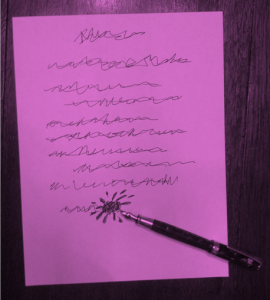When that editor rejected your story because your prose was “too purple,” she wasn’t referring to your font color. What is purple prose and how can you avoid it?
Purple prose refers to text using overly long and fancy words, elaborate phrases, and flowery language. It overuses abstractions, figurative language, modifiers, similes, and metaphors. It stretches sentences out until the reader drowns in pleasant-sounding but meaningless words.
 Since that description is rather subjective, I prefer the simpler version provided by Stephanie Nolan: “Purple prose draws attention to itself.”
Since that description is rather subjective, I prefer the simpler version provided by Stephanie Nolan: “Purple prose draws attention to itself.”
That may sound like something you’d have to do intentionally, something requiring extra effort, something easy to avoid. In reality, it’s easy to slip into the trap of writing purple prose. One method is by familiarity. If, like me, you enjoy reading books written in an era when purple prose wasn’t abhorred (looking at you, Jules Verne), then you can come to believe such writing is still acceptable.
Or, like Liz Bureman notes, you can drift into the purple zone when you can’t think of anything relevant to write about the characters or the plot. At such times, you might be tempted to litter the page with long descriptions of the setting, or of a character’s clothing.
Some of you might be thinking I’m being unfair to purple prose. What, you’re asking, is so bad about it? After all, some readers like high-sounding writing with ornate phrases, detailed imagery, and delicious turns of phrase. True, a few readers may enjoy that. However, the purpose of fiction is to tell a story about the human condition. If your prose meanders off on some tangent and strays too far from the characters and plot, most readers today will recognize they’re being cheated. They’ll cease reading, never read anything else you write, and post a harsh review of your book online.
By the way, the term purple prose isn’t exactly new. As Richard Nordquist states, it was coined by Horace (65-68 B.C.) who mentioned purpureus pannus (Latin for purple patch) in his Ars Poetica. Nor is ‘purple prose’ the only label for such writing. Nordquist also cites related terms: Adjectivitis, Bomphiologia, Cacozelia, Euphuism, Gongorism, Grand Style, Overwriting, Bugbear Style, Skotison, Tall Talk, and Verbosity.
For humorous examples of purple prose, skim through the winning entry and dishonorable mentions in the annual Bulwer-Lytton Contest’s Purple Prose category.
How can you avoid writing purple prose? Early on, the surest method is to have someone else point it out to you. You can hire an editor, join a critique group, or trust a Beta Reader. In time you’ll learn to pick it up yourself while self-editing your work. Look for excessive descriptions, unnecessary adjectives and (especially) adverbs, and any significant deviations away from the action or characters.
Tracy Culleton says whenever you find yourself showing off, that’s a sign you should delete that phrase. However, if it serves the telling of the story, keep it. Stefanie Arroyo says admiring your own phrasing is a danger sign. If you find yourself thinking, “That’s a lovely phrase,” that’s reason enough to consider killing it.
There are a couple of times when purple prose is okay. First, you can certainly use it for humorous effect in a story intended to be funny. Second, feel free to let your prose run purple in your first drafts, so long as you cut out the worst parts in later drafts. In that first draft, your subconscious (or your muse) is having fun lingering on a long description of an object, or setting, or clothing, etc. Maybe some description is called for, but in later drafts you should trim it down to the essentials.
Purple is a fine color, but purple prose is not fine writing. Pledge to purge purple prose from your paragraphs and passages, and proffer all praise for your newly procured perception and proficiency to—
Poseidon’s Scribe
